NRAO eNews
June 2009 • Vol. 2, Iss. 6
- Upcoming Events
- 2009 Jansky Lectureship Awarded
- The NRAO and the Astro2010 Decadal Survey
- ALMA Construction
- Expanded Very Large Array Project Status
- EVLA Bandpass Stability
- Early EVLA Polarimetric Characterization
- Career Opportunities
- Past Issues
- Contact the Editor
- Subscribe
- More Information
NRAO eNews: June 2009 • Volume 2, Issue 6

The NRAO Expanded Very Large Array near Socorro, New Mexico.
Upcoming Events
 NAIC-NRAO School on Single-Dish Radio Astronomy
NAIC-NRAO School on Single-Dish Radio Astronomy
July 12-18, 2009 | Arecibo Observatory, Puerto Rico
 VLBA Astrometry Workshop
VLBA Astrometry Workshop
July 21-23, 2009 | Socorro, NM
 XXVIIth IAU General Assembly
XXVIIth IAU General Assembly
August 3-14, 2009 | Rio de Janeiro, Brazil
 Assembly, Gas Content and Star Formation History of Galaxies
Assembly, Gas Content and Star Formation History of Galaxies
September 21-24, 2009 | Charlottesville, VA
 SKA 2009 Science and Engineering Meeting
SKA 2009 Science and Engineering Meeting
October 29-31, 2009 | Manchester, UK
2009 Jansky Lectureship Awarded
Fred K.Y. Lo
The National Radio Astronomy Observatory is pleased to announce that the 2009 Karl G. Jansky Lectureship has been awarded to Dr. Anthony C. S. Readhead, Director of the Owens Valley Radio Observatory, Caltech. The Jansky Lectureship is an honor established by the trustees of Associated Universities, Inc., to recognize outstanding contributions to the advancement of radio astronomy. Each award recipient presents a scientific lecture at the NRAO facilities. The title, abstract, and schedule for Dr. Readhead's Jansky Lectures will be announced later this summer. Additional information about the Jansky Lectureship is online.
Anthony Readhead studied physics and mathematics at the University of the Witwatersrand in South Africa. He continued his education in England at the Cavendish Laboratory, University of Cambridge, where he conducted Ph.D. research on active galaxies and interplanetary scintillation under Antony Hewish, winner of the 1974 Nobel Prize in Physics. Dr. Readhead was awarded the Royal Society Weir Research Fellowship, dividing his time between Cambridge and Caltech (1972-77) while using Very Long Baseline Interferometry (VLBI) to study active galaxies.
Readhead first visited the NRAO in spring 1975 just as the first VLBI Mk II correlator became operational. He returned to Caltech in 1977 where he was appointed professor of astronomy in 1981. From 1981-86, Readhead was the Director of the Owens Valley Radio Observatory. He contributed to the development of the technique of "Hybrid Mapping," now known as "Self Calibration," and continued his research on active galaxies. Since the late 1970s, he has also made significant contributions to our understanding of the Cosmic Microwave Background (CMB) radiation. Following his election to the National Academy of Sciences and the American Academy of Arts and Sciences in 1995, Readhead led the team that developed, built, and operated the Cosmic Background Imager in Chile that measured the CMB total intensity and polarization spectra on small angular scales.
Readhead is now a collaborator on the innovative Q/U Imaging ExperimenT (QUIET) that will make sensitive measurements of the CMB radiation polarization, and is focusing his attention on the development of coherent detector arrays for radio astronomy. He is also the Director of the Owens Valley Radio Observatory and the Chajnantor Observatory.
We are pleased to have a scientist of Dr. Readhead's stature for the 2009 Jansky Lectureship, and we look forward to his visit and presentation this fall.
The NRAO and the Astro2010 Decadal Survey
Tim Bastian and Chris Carilli

With the launch of the Astro2010 Astronomy and Astrophysics Decadal Survey, the NRAO has been assisting the astronomical community in their efforts to determine the major scientific priorities and future instrumentation required for the coming decade.
In fall 2008, a working group was established by the NRAO to review the reports of many community groups, Observatory staff, and advisory committees – such as the McCray report to Associated Universities, Inc. and NRAO – and to identify the primary scientific themes in radio astronomy in the coming decade. Work with the community rapidly ramped up with the Astro2010 call for scientific and project white papers in January 2009. The NRAO staff participated in numerous science white papers that spell-out a clear and compelling program of groundbreaking research in areas ranging from the Solar System, to the Milky Way and nearby galaxies, back to the earliest galaxies in the Universe, and cosmology.
ALMA and the EVLA represent dramatic improvement in observational capabilities at centimeter through submillimeter wavelengths. These facilities will begin full operations early in the next decade. Likewise, planned upgrades to the GBT and the VLBA represent uniquely powerful resources for the astronomical community. Based on the science white papers, NRAO presented a series of project white papers to the Astro2010 Decadal Survey that build on the community’s major investments in these instruments and seek to enable dramatic scientific returns for only modest additional investment. These projects also build the scientific and technical vision for future large-scale radio arrays, as captured in the SKA program.
The NRAO also submitted a white paper to the Astro2010 Subcommittee on the State of the Profession that outlines the overall mission and vision of the Observatory in the next decade and beyond. Beyond building and operating a world-leading suite of major radio facilities, a primary goal of the Observatory is to make all of these facilities easily accessible to the full astronomical community. The NRAO also anticipates playing a major role in the technical and scientific development of the SKA program. In combination with large ground-based optical facilities, and future space observatories, the NRAO-operated radio facilities will continue to drive the exponential growth in astrophysical science and understanding through the next decade.
ALMA Construction
Al Wootten
Dynamic Fringes Achieved at the Operations Support Facility
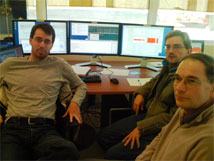
Figure 1: The Dynamic Fringe team ponders success: (left to right) Jeff Kern, Lewis Knee, Robert Lucas.
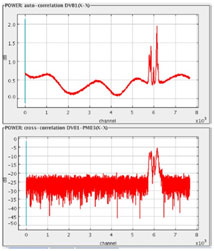
Figure 2: Upper panel: The spectrum of the 86 GHz SiO maser toward Orion, as observed by ALMA Vertex antenna AIV1. Lower panel: The interferometer spectrum on the baseline to the Melco antenna.
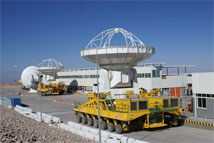
Figure 3: Vertex antennas No. 4 and No. 2 were moved to new foundations at the Operations Support Facility as testing continued. Photo: Luis Roa.
The first two ALMA antennas were pointed at an astronomical source, Mars, on April 30 and ‘static’ fringes were observed, i.e., software did not control or follow the changes in the fringes as the source followed its diurnal path. Updated ALMA software (v6.1) has now been installed, and on June 12 ‘dynamic’ fringes were obtained, for which computations are continually updated to drive the electronics and track the changes in the fringes as the source treks across the sky. The spectral lines from the silicon monoxide (SiO) maser in the heart of the Orion Molecular Cloud were observed at 86 GHz by a team that included Jeff Kern, Robert Lucas, and Lewis Knee.
The ‘single antenna’ spectrum from the Vertex antenna, and the spectrum on the 69.7m baseline between the two antennas are shown in the upper and lower panels, respectively, in Figure 2. The baseline variations seen in the upper spectrum will be removed by calibration, not applied in these test spectra. The two spectra differ because of the lack of calibration and becuase of intrinsic source structure. The interferometer is more sensitive to small-scale structure, and measuring these differences on many scales (baselines) leads to a high-resolution image of the source. In this case, the primary beamwidth of the 12m antenna is 72 arcsec, and the scales to which the interferometer is sensitive include those shorter than the baseline measured in wavelengths (3.5mm), or ~ 8 arcsec.
Meanwhile, the surface of the Vertex antenna accepted in April was set to well within specifications. This antenna has also undergone rigorous pointing tests and been equipped with an ALMA Front End received from the European Front End Integration Center at Rutherford Appleton Labs, a Back End from the NRAO Science Operations Center in Socorro, and other equipment. Radiometric measurements will be conducted soon.
ALMA equipment continues to be delivered to northern Chile. Vertex antenna No. 10 arrived in May and will be erected over the coming months. Figure 3 shows the exchange of two antennas at the Operations Support Facility using the two ALMA Transporters. Each loaded vehicle weighs about one‐third million pounds. Water Vapor Radiometers are also arriving, and the fourth has now gone through acceptance. The second Test Correlator, the device used at the ALMA Test Facility in New Mexico, will arrive soon.
At the high elevation Array Operations Site, the antenna foundation nearest to the Technical Building is receiving its electrical power and optical fiber connections in preparation for the arrival of the first antenna.
Read the Joint ALMA Observatory newsletter.
Expanded Very Large Array Project Status
Mark McKinnon and the EVLA Project Team
Antennas continue to be converted to the Expanded Very Large Array (EVLA) design, and 21 antennas are now used routinely for scientific observations. The conversion of the 22nd EVLA antenna was completed in June. EVLA antennas accounted for 72.3% of all antenna hours used in scientific observations in April 2009. The observing statistics are not as favorable as we had forecasted due to the failure of a gear in one of the two azimuth drive gearboxes on EVLA antenna 5. The gearbox is being repaired.
The first subset of the final WIDAR correlator, known as WIDAR-0, was installed at the VLA site. First fringes were recorded with WIDAR-0 using five antennas and 512 MHz of bandwidth on March 6. Fringes from eight antennas were recorded a week later. WIDAR-0 can accept inputs from up to 10 antennas. It is being used to test, verify, and integrate the two WIDAR configurations used in early science observations in Q1 2010. After that, WIDAR capabilities will grow in accordance with the recommendations of the 2008 SAGE (see the Dec 08 eNews article).
The delivery of WIDAR circuit boards is proceeding according to schedule. Nine crossbar boards and 22 station boards were shipped from the Dominion Radio Astrophysical Observatory in Penticton, British Columbia to the VLA site on June 1. Final laboratory tests of WIDAR’s baseline boards were completed in late May. The production order for these boards will be placed this summer.
Good progress has been made with the development and deployment of fully ELVA- compliant receivers. Three EVLA antennas now have the new S-band (2-4 GHz) receiver. First fringes at S-band were recorded on April 8. The production order for the receiver’s wideband orthomode transducer (OMT) was received. Prototype parts (e.g. OMT, phase shifter, circular to square waveguide transitions, and the 45 degree twist) for the Ku-band (12-18 GHz) receiver have been manufactured, and the assembly of the prototype receiver is underway. Ten, fully EVLA-compliant, C-band (4-8 GHz) receivers are installed on antennas in the array. The production order for the C-band OMTs was received in February. Ten Ka-band (26-40 GHz) receivers have been assembled and installed on EVLA antennas, with three more receivers to be installed in the coming month. Tests of the first, fully-EVLA compliant, L-band (1-2 GHz) receiver are underway. The full production of the L-band receiver should commence this year.
A new direct digital synthesizer (DDS) has been designed for use in the L302 frequency synthesizer. The old DDS has thermal dissipation problems, but the new DDS cannot be used with the old correlator due to its frequency resolution. The new DDS will only be used with the new correlator. All of the old DDSs will be changed out as part of a L302 retrofit when the old correlator is turned off.
The production of the sampler modules that contain the 3-bit, 4Gsps digitizers is still delayed due to a clocking problem encountered with a serial-to-parallel converter on the sampler board. The layout of the board has been revised, and the testing of the revised board is underway. If testing goes well, the production of the sampler modules could resume in the early fall 2009.
Work in the monitor and control group has focused on support of WIDAR-0. A new Correlator BackEnd (CBE) cluster for WIDAR-0, and eventually for the full WIDAR, was purchased and installed. The cluster currently consists of four nodes, with different input/output configurations, in order to best investigate how these different configurations affect final system performance. This investigation may allow us to reduce significantly the number of nodes needed in the final version of the cluster. A significant amount of new software, which enabled the handling of auxiliary data products from other parts of the system, was installed on the CBE cluster. The Correlator Power Control Computer (CPCC) software was upgraded to support WIDAR-0. This software supports turning on and off circuit boards, cooling fans, and other correlator room components.
The new web-based Observation Preparation Tool (OPT) is now available to observers and has already been used for science observations. The new OPT is the only supported way to access the extended tuning ranges of the EVLA, such as those provided by the new Ka-band and C-band receivers. A temporary web page has been set up for help on getting started with the OPT. At this moment, Firefox is the only web browser for which the OPT is supported. The OPT is now available via the NRAO User Portal. Users must be registered with that web-site to use the OPT.
An EVLA Advisory Committee meeting was held March 19-20, 2009. The Committee was very impressed with the overall project progress. The Committee findings and recommendations include developing science-driven plans for archiving EVLA data and getting the data to users, taking more action to ensure user acceptance of CASA, maintaining and growing a vibrant science community at Socorro for the EVLA, and quickly developing a vision for high-impact science.
A science workshop on “The EVLA Vision: Stars On and Off the Main Sequence” was held in Socorro May 26-28. Fifty-two scientists from around the world participated. The purpose of the workshop was to explore how the new capabilities provided by the EVLA might be harnessed in stellar studies, such as new source populations, circumstellar chemistry, and fast and sensitive time response to transient events. The workshop program can be found online.
EVLA Bandpass Stability
Miller Goss
In two VLA proposals with Snezana Stanimirovic (Univ Wisconsin), Carl Heiles (UC-Berkeley), and Ayesha Begum (Univ Wisconsin), we have investigated weak galactic HI lines in the direction of the extragalactic sources AS931 and AB1325. These lines have opacities of several times 0.001. In the direction of 3C286 we confirmed the weak lines detected by Stanimirovic and Heiles at Arecibo with opacities of 0.005 to 0.006 (Fig 1).
For baselines using only VLA antennas, the bandpass stability (in 1.56 MHz total bandwidth mode) is typical of the previous VLA system, with fluctuations in the bandpass at the level of 0.002 in tau (left panel, Fig 1). But with the new EVLA optical fiber system and the VLA correlator, the bandpass is remarkably stable, i.e., to better than a few parts in 10,000 (right panel, Fig 1). New observations (May 2009) in the direction of additional sources confirm this stability; in particular, observations of 3C273 shows the tau=0.02 line easily with a bandpass that is flat at the level of a few times a part in 10,000.
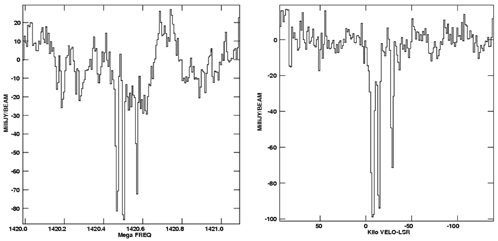
Galactic HI absorption spectra towards 3C286. Left panel: Spectrum obtained using only VLA antennas. Right panel: Spectrum obtained using EVLA antennas. The VLA-only spectrum shows distortions at the level of 40 mJy/beam in the bandpass in spite of frequent bandpass calibration, compared with <16 mJy/beam for the EVLA antennas.
Early EVLA Polarimetric Characterization
Bob Sault and Rick Perley
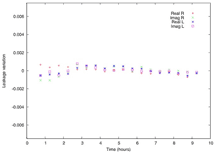
Figure 1: Variation in the antenna polarimetric leakages for antenna 3 at 5.885 GHz during a 10-hour observation.
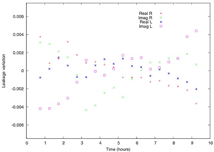
Figure 2: Variation in the antenna polarimetric leakages for antenna 3 at 19.265 GHz over a 10-hour observation.
One of the goals of the EVLA upgrade is to be able to produce polarimetric images that are limited by noise rather than systematics. This can be achieved through stable polarizers and software that accurately handles polarimetric calibration and modeling, including the off-axis EVLA antenna response. The design of the polarizers in the antenna feed varies between the different EVLA observing bands. This note focuses on some early characterization of the polarizers at C and K bands and the measurement of the stability of the so-called polarimetric leakage terms. The C and K bands use orthomode transducer and waveguide designs respectively, being representative of the L/S/C and Ku/K/Ka band polarizers.
Measurements show that the C-band leakages vary over an 8-hour synthesis at the level of 10-3, whereas the K-band leakages are a factor of two less stable. These stability measurements were near the thermal limit of the accuracy with which they could be determined. Figures 1 and 2 show the variation of the leakages over an 8-hour period on some of the better behaved antennas (some antennas are worse). Over weeks, the C-band leakages are stable to the level of about 0.01.
A useful rule of thumb for a long synthesis with the EVLA is that the "polarimetric dynamic range" (the peak Stokes I flux density divided by the artifacts in the Stokes Q and U images) is limited to about ten times the absolute stability of the uncorrected time-varying leakage. This suggests that a polarimetric dynamic range of about 1000 should be achievable in reference images using polarimetric calibration that the observatory determines every few weeks. This might be the limit when an observation is formed from many smaller blocks (e.g. short dynamic scheduled blocks). An order of magnitude improvement can be expected when using a polarimetric calibration determined as part of a long synthesis. A further improvement is possible when time-varying leakage solutions are determined as part of the long synthesis. The latter is more important at K band.
For more information, see EVLA memos 131 and 134.
Career Opportunities
New Postings
Test Scientists - ALMA: ALMA is opening positions for Test Scientists to participate in system tests during the Assembly, Integration and Verification processes. Test Scientists will be part of the team responsible for ensuring that appropriate testing has been accomplished to verify that the system requirements have been met including developing qualification tests, analyzing results and approving reports. The positions are based in Santiago, Chile and will require frequent travel to the ALMA Operational Support Facility near San Pedro, Atacama.
Web Analyst/Developer: The North American ALMA Science Center is seeking a Web Analyst/Developer to work in consultation with observatory scientific, technical, and design staff to plan, develop, and maintain websites and web portals that communicate technical information to external users of observatory research facilities.

 Zoom
Zoom